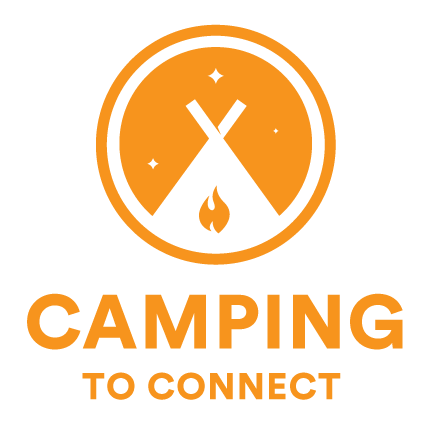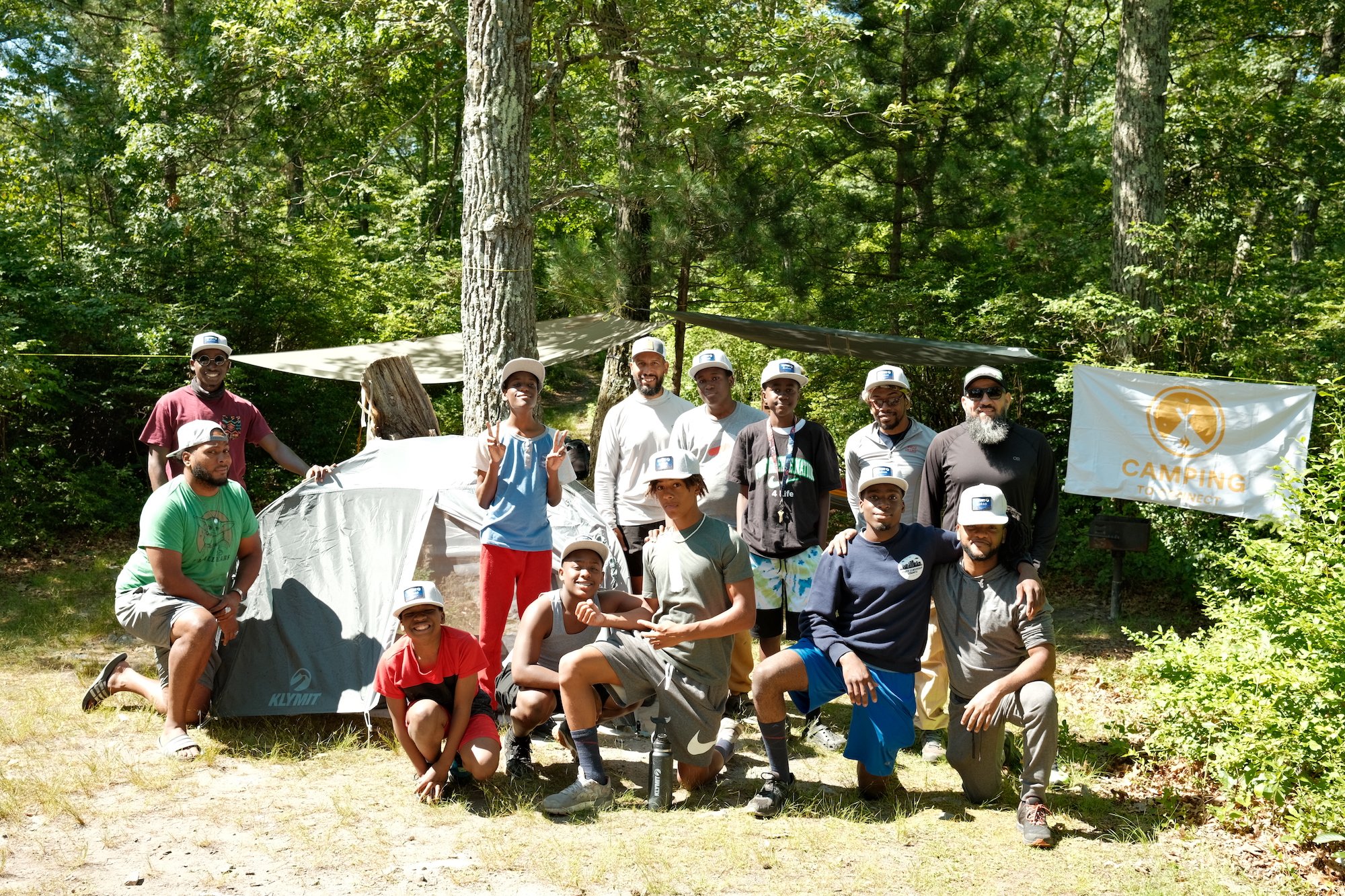NYT: The Mental Health Benefits of an Inclusive Outdoor Escape
Amid pandemic stress and racial violence, many communities of color have turned to wilderness areas for healing.
Last weekend the New York Times published a story that directly speaks about the work of organizations like Camping to Connect do; addressing the issue of nature deficiency in communities of color, and diversity and inclusion in the outdoors.
Original article by Alisha Haridasani Gupta for The New York Times.
Photos by Camping to Connect, an outdoor mentorship program for young men of color.
For Cynthia Philips, it was the sound of bees, willows, crickets and the hum of a metallic Tibetan bowl that helped her overcome some of her anxieties.
Over Memorial Day weekend, Ms. Philips, a 64-year-old entrepreneur, drove out to a Black-owned ranch in Crawfordville, Ga. where she joined dozens of other women for a camping trip. Tents were set up under large, majestic trees and hammocks were strung about. Over two days, the women did yoga, hiked, meditated, wrote in their journals and shared their life stories with each other. They were there to heal.
Before the trip, recent events — shootings in New York and Texas, a rise in hate crimes, the reversal of abortion rights — were keeping Ms. Philips up at night. “What is happening here is so devastating and poisonous,” she said. “I have young Black nieces and nephews to worry about.”
During the pandemic, she also had to sell her business, a gym in Atlanta that she had poured her savings into, which had left her feeling defeated.
At the campsite, Ms. Philips participated in what is known as a sound bath — using waves of sounds, produced with tools like metallic bowls or gongs, to meditate. “To be in nature and have those sounds surround me — there was a peacefulness and a serenity to it.” It helped her feel connected to the forest, she said, and get past some of her heartbreak.
While ancient philosophers from Aristotle to Siddhartha have long known that the outdoors can be an emotional and mental balm, and scientists have repeatedly documented it, people of color have not had equal access to some of the spaces that could provide mental health benefits. Throughout the 19th and 20th centuries, they were systematically excluded from outdoor recreational spaces (until the 1940s and 1950s, many state and national parks had signs that read “For Whites Only”) and all but scrubbed from the mythical narrative of the great American outdoors.
Today, there are some signs of change. Over the last three years, the number of Hispanic and Black people participating in outdoor activities (including hiking, jogging, fishing and camping) has increased, according to a 2021 report by the Outdoor Foundation, a nonprofit associated with an outdoor industry trade group. Participation among Asians, however, declined and most outdoor participants remain overwhelmingly white.
A growing number of organizations and online forums have also sprung up across the country encouraging communities of color to step outdoors as a way to improve mental health. The Georgia camp out, for instance, was organized by Outdoor Journal Tour, a group that also leads one-day hikes around the country. According to Kenya Jackson-Saulters, one of the founders, attendance this year was double that of last year.
Other similar organizations, many of which are often centered around Black, Indigenous and Hispanic communities, like Outdoor Afro and Hike Clerb, have also seen a surge of participants in recent years. Tickets for hikes would sell out “within minutes” during the pandemic, Hike Clerb’s founder, Evelyn Escobar, said. Because of demand, the group will be opening a New York chapter later this year.
“The growth has truly been astronomical,” Ms. Escobar said. “There are so many people around the country who just want to feel a sense of belonging and be able to tap into the healing energy of a collective safe space outside.”
From awe to peace
There is a growing body of evidence for the mental health benefits of wilderness and nature-based therapy, often called ecotherapy. The first rigorous science on wilderness healing came from Japan in the late 1990s and early 2000s. Several Japanese researchers collected health data from hikers before and after short excursions into the lush forests of Japan and found that time spent in nature was correlated with reduced blood pressure and cortisol (a stress hormone) levels, better immune function and improved sleep.
Since then, other researchers have found that even smaller doses of nature, from walking down a tree-lined street to having an indoor plant at home, can have health benefits.
Though much of the existing ecotherapy research has not focused on people of color, one of the reasons that experts suggest nature is effective at bolstering mental health is because of its ability to inspire awe. Awe is the sensation of being confronted by something so vast that it forces us to reconsider our understanding of the world, according to the researchers Dacher Keltner and Jonathan Haidt who published a paper on the emotion in 2010. While “vastness,” at its most basic level, means physical size and beauty (the ocean or a mountain range), vastness can also refer to less tangible elements, like the depth of talent (watching an incredible musician).
One study published in 2018 by researchers at the University of California, Berkeley, found that 124 military veterans and youth from underserved communities reported a 21 percent improvement in PTSD symptoms after whitewater rafting trips.
While participants, more than half of whom were people of color, felt a range of positive emotions, said Craig Anderson, an author of the paper, it was awe that was most strongly correlated with improved well-being. In further studies on the topic, Dr. Anderson found that a sense of awe can also come from “fleeting moments in our daily lives,” whether that’s watching a sunset to seeing a flower blossom.
Focusing on the complexity of nature — all the different parts working as a cohesive whole — can also reveal its vastness and inspire awe, said Aaron Leonard, a campaign manager at the Sierra Club, who focuses on helping veterans find healing through outdoor activities. On his trips, Mr. Leonard asks participants to download a free app that helps identify plants by using the phone’s camera, which he said always leaves participants feeling more appreciative of their surroundings.
“You’ve got to touch, taste, smell or listen, gain a little bit of knowledge, get all your senses involved, in order to go deeper into the experience,” Mr. Leonard said.
Overcoming the barriers to the outdoors
At a time when people of color have reported increased levels of stress, trauma and anxiety, experts suggest nature experiences might be a crucial coping tool. But getting outdoors is often easier said than done. A 2020 analysis by the Center for American Progress found that Black, Hispanic and Asian communities are three times as likely as white people to live in nature deprived areas, or areas affected by urban sprawl, drilling, mining or logging. That makes getting to the nearest park or outdoor space expensive and time consuming. And, without exposure to nature in the first place, many might not discover the benefits of being outside or the joy it might bring them.
Awe-inspiring natural spaces in the U.S., like national parks, are also tarnished with racist histories, according to Tracy Perkins, an assistant professor at Arizona State University who studies social inequality and environmental justice. Many environmental conservation efforts starting in the late 1800s were led by eugenicists, like Madison Grant, to create spaces for white people to get fresh air and exercise in order “to preserve the vitality of white race,” she said.
Additionally, the outdoors can bring up connotations of enslavement and lynching for Black communities and violent displacement for Indigenous people, and many continue to experience discrimination in outdoor recreational spaces. The birder Christian Cooper’s encounter with a white woman in Manhattan’s Central Park in 2020, for example, or the fatal shooting of Ahmaud Arbery in Georgia while he was said to be out jogging have spotlighted some of the difficulties of being a nonwhite person outdoors.
Seemingly simple activities, like a walk in the park, can unconsciously trigger a fight or flight response for some people, making them hypervigilant for dangers, said Laura Marques Brown, a clinician at Anchored Hope Therapy in Maryland who specializes in nature-based therapy for low-income people of color. “I remind ecotherapists, especially white ones, to consider how walking through dense woods as a Black person might feel.”
Acknowledging the racist history of the outdoors is an important first step toward making people of color feel safer in nature, Ms. Marques Brown said. She, for example, begins her one-on-one outdoor sessions by walking clients through the history of the Indigenous land that the clinic is on in an effort to make them feel less alienated in that natural space.
“I tell my clients that when we go outside, we are with generations of family,” she said.
For others, joining a group outing can also help puncture some of that unease. While Ms. Philips, the 64-year-old camper, went on a solo backpacking trip through Europe years ago, she now feels less confident outdoors in light of the recent spike in violence against people of color. When she started hiking with Outdoor Journal, she found the diversity of the group comforting. It felt “like a village,” she said.
In 2019, Charmaine Tillet, a 52-year-old veteran who, after 15 years in the military, was dealing with PTSD, found a sense of “camaraderie” when she joined one of Mr. Leonard’s outdoor hikes.
“I would feel almost like I’m suffocating around crowds, I had anxiety driving, I had anxiety in grocery stores, I couldn’t leave the house. I wouldn’t leave the house,” she said.
When she went on her first camping trip with the Sierra Club, with a group of other female veterans, she began to heal, she said. “Being able to just take in the noises and sights of nature — there were birds, we had a raccoon show up to our campsite” helped her relax, she said.
At one point, when they did yoga by the water, she fell asleep.
“It was the best sleep I’ve ever had,” she said.
____
Watch the trailer for WOOD HOOD, a documentary short film about —and produced by— Camping to Connect.
About Camping to Connect
Camping to Connect is a Black, Indigenous and people of color (BIPOC) lead immersive, experiential, mentorship program that uses nature-based outdoor recreation to address the diverse issues faced by young men of traditionally underserved (BIPOC) communities. Offered at no cost to participants, Camping to Connect is a program of the Young Masterminds Initiative, Inc., a 501(c)(3) nonprofit organization founded by a collective of progressive men of color who believe in inspiring change by nurturing camaraderie, fostering accountability, and cultivating trust, leadership, and support.






